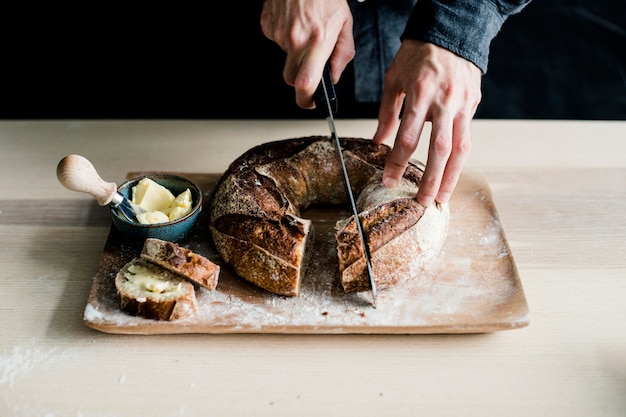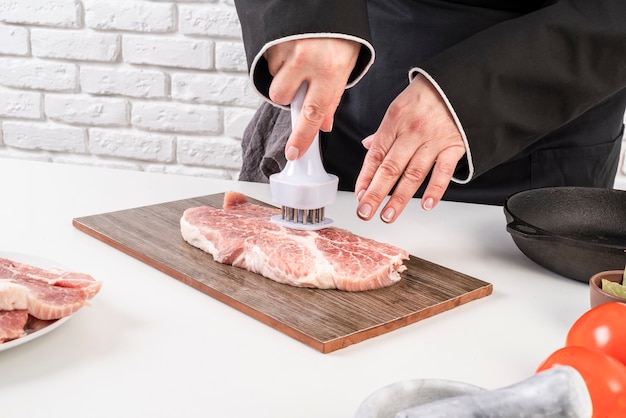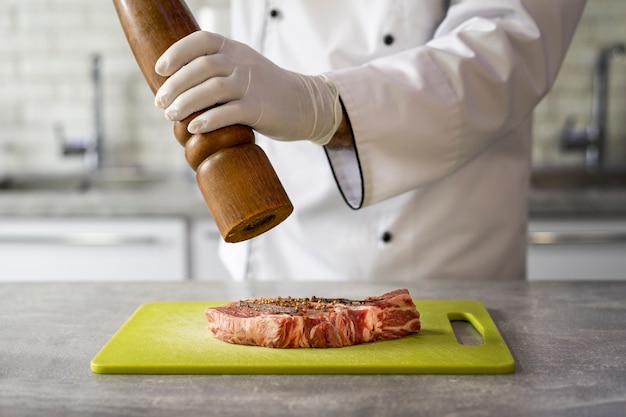Alright, let's talk steak. Not just any steak, mind you, but that glorious, succulent strip steak. The one with the perfect balance of tenderness and flavour, that melts in your mouth like butter. I'm talking about the kind of steak that makes you sigh with contentment after every bite, the kind that turns a simple meal into a culinary masterpiece.
For years, I've been on a quest to master the art of cooking strip steak. From burnt offerings to disappointing raw centres, I've been through the gamut. But through trial and error, I've finally cracked the code. Now, I'm going to share my secrets with you, so you too can become a steak-cooking champion. Ready to embark on this culinary adventure with me? Let's dive in!
(Part 1) The Right Strip Steak

You can't expect to cook a perfect steak if you don't start with the right cut. Strip steak, also known as new york strip, is a cut from the short loin of beef. It's known for its robust flavour and the beautiful marbling that gives it that melt-in-your-mouth tenderness. Think of it as a steak that's been kissed by a generous hand with rich, buttery fat – the more, the merrier!
choosing the right cut
Now, here’s the thing, not all strip steaks are created equal. I've learned this the hard way, trust me. You want to look for a steak that's about 1 to 1.5 inches thick, with a good amount of marbling. You can tell if it's well-marbled by looking at the fat distribution - it should be evenly spread throughout the steak, not just concentrated in one area. Avoid steaks that are too thin, they'll dry out easily, and those that are too thick, they'll take ages to cook. Think of it like a Goldilocks situation - just right!
Grading
Now, you'll see different grades on the steak, like Select, Choice, and Prime. Prime is the highest grade, and it's usually the most flavorful and tender. But, it's also the most expensive. Imagine it as the VIP of steaks – pampered, delicious, and a bit of a splurge. Choice is a good middle ground, offering decent flavour and tenderness at a more reasonable price. It's the reliable friend who always delivers. Select is the lowest grade, but it's still perfectly edible. It's just not going to be as flavorful as the other two. Think of it as the everyday steak, a solid option for a weeknight meal. Ultimately, the grade is up to you and your budget.
(Part 2) Preparing Your Strip Steak

Once you’ve got your prime cut of strip steak, it’s time to prep it for cooking. This might seem simple, but trust me, a few extra steps can make all the difference. It's like giving your steak a little spa treatment before its grand entrance.
Patting Dry
First things first, pat your steak dry with paper towels. This helps ensure that it sears evenly and prevents it from steaming instead of browning. Think of it like a dry canvas for a beautiful masterpiece. You can’t have a beautiful sear if you’ve got moisture clinging to the surface.
Seasoning
Now for the seasoning! I'm a simple guy, so I usually just use salt and pepper. But feel free to experiment with other spices like garlic powder, onion powder, paprika, or even a pinch of cayenne pepper if you like a bit of a kick. Don’t go overboard though, you don’t want to mask the natural flavour of the steak. Think of it like adding a touch of colour to a beautiful painting – subtle accents enhance the overall beauty.
A Little Trick
Here's a little trick I picked up from a seasoned chef. Season your steak generously with salt and pepper, then leave it uncovered in the fridge for at least 30 minutes, or even up to an hour. This helps to draw out moisture and create a more flavorful crust. Just remember to take it out of the fridge about 30 minutes before you’re ready to cook it so it can come to room temperature. Think of it as letting the steak relax and breathe before the heat treatment.
(Part 3) Cooking Methods

Now for the fun part, the actual cooking! There are a few different methods you can use to cook your strip steak. I'm going to talk about the three most popular methods: pan-searing, grilling, and broiling.
Pan-Searing
This is my go-to method for cooking strip steak. It's quick, easy, and produces a beautiful, crispy crust. Think of it like a quick and satisfying hug for your steak, resulting in a delicious, golden brown embrace.
Choosing the Right Pan
You’ll want to use a heavy-bottomed pan like cast iron or stainless steel. This helps to distribute heat evenly and prevent the steak from sticking. It's like giving your steak a sturdy platform for a perfectly balanced heat treatment. Now, the pan needs to be super hot. I'm talking smoking hot. Add a good amount of oil to the pan, enough to coat the bottom. Then, heat it over high heat until the oil starts to shimmer. Imagine it as a sizzling stage for your steak to shine.
Searing
Now, carefully place your steak in the pan, making sure not to overcrowd it. You should hear a satisfying sizzle as the steak hits the pan. Don’t touch it for at least 2-3 minutes. Let it sear until a beautiful crust forms. Then, use tongs to flip the steak over and sear the other side for another 2-3 minutes. Think of it as a gentle dance, letting the steak bask in the heat, creating a beautiful, golden brown canvas.
Finishing
Once you’ve seared both sides, reduce the heat to medium-low and cook the steak for another 2-3 minutes per side, or until it reaches your desired doneness. Think of it as a finishing touch, allowing the steak to reach its full potential.
Grilling
Grilling is another excellent way to cook strip steak. It gives it that smoky flavour that’s hard to resist. Think of it as a barbecue party for your taste buds.
Getting the Grill Ready
You’ll want to preheat your grill to medium-high heat, about 400-450 degrees Fahrenheit. If you have a gas grill, you’ll want to make sure that the heat is evenly distributed. If you have a charcoal grill, make sure the coals are white-hot before you add the steak. Think of it as setting the stage for a delicious performance.
Grilling
Place your steak on the grill and cook for 3-4 minutes per side, or until it reaches your desired doneness. You might want to move the steak around the grill to ensure even cooking. Think of it as giving your steak a little spin on the dance floor, ensuring it receives equal attention from the heat.
Broiling
Broiling is a quick and easy way to cook strip steak, especially if you don’t have a grill. Think of it as a shortcut to a delicious steak.
Preparing the Oven
Preheat your oven’s broiler to high. Place a baking sheet in the oven to catch any drips. Think of it as preparing the stage for a quick and fiery performance.
Broiling
Place your steak on the baking sheet and broil for 3-4 minutes per side, or until it reaches your desired doneness. Keep an eye on the steak, because it can go from rare to well-done very quickly. Think of it as a quick burst of heat, requiring a watchful eye to ensure the perfect outcome.
(Part 4) Doneness
Now, this is where things get a bit tricky. You’ve got to know how to tell when your steak is cooked to your liking. Think of it like a delicate dance between heat and time.
Doneness Levels
Here’s a quick guide to the different levels of doneness:
| Doneness | internal temperature | Characteristics |
|---|---|---|
| Rare | 125-130°F (52-54°C) | Red center, cool to the touch |
| Medium-Rare | 130-135°F (54-57°C) | Pink center, warm to the touch |
| Medium | 135-140°F (57-60°C) | Slightly pink center, warm to the touch |
| Medium-Well | 140-145°F (60-63°C) | Very little pink, warm to the touch |
| Well-Done | 145-150°F (63-66°C) | No pink, hot to the touch |
Doneness Check
There are a couple of ways to check your steak’s doneness. You can use a meat thermometer, which is the most accurate method. Just insert the thermometer into the thickest part of the steak, making sure it doesn’t touch any bone. Think of it as a scientific approach to ensuring perfection.
Touch Test
If you don’t have a thermometer, you can use the touch test. Press your finger into the middle of the steak. If it feels firm and springy, it’s rare. If it feels slightly firm and gives a little, it’s medium-rare. If it feels soft and gives easily, it’s medium. Think of it as a tactile gauge, like feeling the texture of a ripe fruit.
Resting
Once your steak is cooked to your liking, it’s important to let it rest for 5-10 minutes before slicing and serving. This allows the juices to redistribute throughout the steak, resulting in a more tender and juicy steak. Think of it as giving the steak a moment to regain its composure after its fiery ordeal.
(Part 5) The Perfect Sauce
The perfect steak deserves a delicious sauce to complement its flavour. I've got a few favourites that I'll share with you. Think of it as adding a touch of drama to your culinary masterpiece.
The Classic Béarnaise Sauce
Béarnaise sauce is a classic accompaniment to steak, made with clarified butter, egg yolks, white wine vinegar, and herbs. It's rich, creamy, and slightly tangy, making it the perfect complement to a juicy strip steak. Imagine it as a luxurious velvet curtain, adding a touch of elegance and sophistication.
A Simple Red Wine Sauce
This is a super easy sauce that you can whip up in a few minutes. Just deglaze the pan you cooked the steak in with red wine, then add some butter and herbs. It's a simple but effective sauce that really elevates the flavour of the steak. Think of it as a quick and satisfying side dish, adding depth and richness to your steak.
Garlic Herb Butter
For a simple but delicious sauce, try melted garlic herb butter. Just melt some butter in a saucepan over low heat, then stir in some minced garlic, fresh herbs, and a pinch of salt and pepper. It's a flavour bomb that's sure to please everyone. Imagine it as a burst of flavour, a delicious symphony for your taste buds.
(Part 6) Sides and Accompaniments
Now, we can’t have steak without the right sides and accompaniments. I’m talking about the supporting cast that takes your meal from good to great. Think of it as the supporting actors who bring your steak story to life.
Roasted Vegetables
Roasted vegetables are a classic accompaniment to steak. They offer a perfect balance of sweetness and savory notes that complement the rich flavor of the steak. You can roast a variety of vegetables like Brussels sprouts, carrots, asparagus, or broccoli. Just toss them with olive oil, salt, pepper, and any herbs you like, and roast them in a preheated oven until tender and slightly caramelized. Think of it as a colourful ensemble cast, adding a touch of vibrancy and complexity.
potato gratin
Potato gratin is another delicious side dish that pairs perfectly with steak. It’s a creamy, cheesy potato dish that's rich and comforting. You can find plenty of recipes online, but I’m a big fan of the classic version made with thinly sliced potatoes, cream, cheese, and garlic. Imagine it as a warm and comforting blanket, adding a touch of richness and indulgence.
Green Salad
A simple green salad is a refreshing contrast to the richness of the steak. You can keep it simple with lettuce, tomatoes, and cucumbers, or get creative with other ingredients like avocado, grilled corn, or crumbled feta cheese. Think of it as a breath of fresh air, a refreshing palate cleanser between bites of steak.
Garlic Bread
Garlic bread is a classic side dish that adds a touch of cheesy goodness to your meal. You can buy pre-made garlic bread from the supermarket, or make your own using a baguette, butter, garlic, and herbs. Think of it as a comforting and familiar companion, adding a touch of warmth and familiarity.
(Part 7) Serving the Steak
You’ve cooked your steak to perfection, you’ve got your sides and accompaniments ready. Now, it’s time to assemble your masterpiece! Think of it as the final act of your culinary play.
Slicing the Steak
Once your steak has rested, slice it against the grain. This helps to tenderize the steak and makes it easier to chew. Think of it as a thoughtful gesture, ensuring a pleasant and satisfying dining experience.
Serving
Place your sliced steak on a platter, alongside your chosen sides and accompaniments. You can also add a dollop of sauce on top of each slice of steak, or place a small bowl of sauce on the side for people to add as they please. Think of it as a carefully curated stage for your culinary creation to shine.
(Part 8) Enjoying Your Steak
You’ve put in the effort, you’ve mastered the art of cooking strip steak to perfection. Now, it’s time to sit back, relax, and enjoy the fruits of your labor! Think of it as the grand finale, a moment to celebrate your culinary achievement.
A Celebration of Flavour
Take a moment to savor each bite, appreciating the tenderness and juiciness of the steak, the richness of the sauce, and the refreshing flavors of the sides. Think of it as a symphony for your senses, a harmonious blend of textures and flavors.
A Culinary Triumph
Cooking a perfect strip steak is a culinary triumph, a testament to your dedication and skills in the kitchen. It’s a dish that will impress your guests and leave you feeling proud of yourself. Think of it as a moment of pride and satisfaction, a testament to your culinary prowess.
FAQs
1. What if my steak is too thick?
If you’re worried about a thick steak taking too long to cook evenly, you can try pounding it to an even thickness. Just place the steak between two sheets of plastic wrap and use a meat mallet to pound it until it’s about 1 inch thick. This will help it to cook more evenly and reduce the cooking time. Think of it as a gentle massage, ensuring a more consistent and even heat treatment.
2. What if my steak is too thin?
If you’ve got a thin steak, you’ll want to cook it quickly to prevent it from drying out. You can use a pan-searing method, but you’ll need to watch it closely and cook it for a shorter time. You can also try grilling it over high heat for a few minutes per side. Think of it as a quick and efficient method, ensuring a tender and juicy result.
3. How do I know if my steak is done?
The most accurate way to tell if your steak is done is to use a meat thermometer. Just insert it into the thickest part of the steak, making sure it doesn’t touch any bone. If you don’t have a thermometer, you can use the touch test or look for visual cues like the colour of the steak. Think of it as a precise tool, providing a scientific approach to culinary perfection.
4. What should I do if my steak is overcooked?
Don’t despair! Even if you’ve overcooked your steak, there are a few things you can do. If it’s just slightly overcooked, you can try slicing it thinly and serving it with a sauce that will help to soften the texture. If it’s well done, you can try making a steak salad. Shred the steak and add it to a salad with your favourite toppings. Think of it as a creative solution, turning a mishap into a delicious opportunity.
5. Can I cook a steak in the microwave?
I wouldn’t recommend cooking a steak in the microwave. It’s not going to give you the same juicy, tender steak that you can get from pan-searing, grilling, or broiling. You’ll end up with a tough, dry steak that’s not worth the effort. Think of it as a culinary sin, a violation of the sacred art of steak cooking.
And there you have it! The ultimate guide to cooking strip steak to perfection. Remember, practice makes perfect, so don’t be afraid to experiment and try different methods until you find what works best for you. Enjoy!
Everyone is watching

Corn on the Cob: The Ultimate Guide to Perfectly Cooked Ears
Healthy MealsAh, corn on the cob. Just the name evokes images of sunny days, barbecues, and that sweet, juicy flavour that ...

Scallops: The Ultimate Guide to Perfect Cooking
Healthy MealsAh, scallops. Those delicate, sweet, and utterly delicious morsels of the sea. They hold a special place in my...

Spaghetti Squash: The Ultimate Guide to Cooking and Serving
Healthy MealsRemember that time you saw spaghetti squash at the supermarket, looking all bumpy and strange, and thought, "W...

Salmon Cooking Times: Perfect Guide for Every Recipe
Healthy MealsLet me tell you, cooking salmon is an art form. It's all about getting that perfect balance: juicy and tender,...

Ham Cooking Time: How Long to Bake, Smoke, or Boil a Delicious Ham
Healthy MealsAh, ham. It's a classic, isn't it? A real crowd-pleaser, especially around holidays. And when done right, it'...
